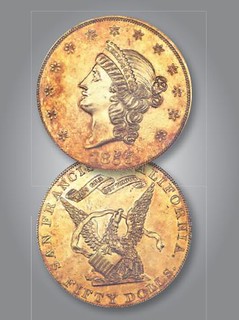
PREV ARTICLE
NEXT ARTICLE
FULL ISSUE
PREV FULL ISSUE
THE AMAZING COLLECTION OF DEWITT S. SMITH
An article by Nancy Oliver and Richard Kelly in the November 2015 issue of The Numismatist (the official publication of the American Numismatic Association) discusses the amazing collection of Dewitt S. Smith. Here's a lengthy excerpt.
-Editor
From the 1860s until his death in 1908, Smith made a fortune in the paper manufacturing industry and, to a degree, the banking business. Both of these endeavors gave him the financial means to purchase many of the most sought-after coins available at the time. Well-known numismatist Thomas L. Elder once called Smith “one of the world’s greatest numismatists.” Upon the latter’s death, Elder stated, “No American numismatist was more highly respected, [and] no other will be more sorely missed from the collectors’ ranks.” DeWitt S. Smith entered the world on April 4, 1840, and was one of four children born to Jared and Caroline Sheldon Smith of Sandisfield, Berkshire County, Massachusetts. His family moved to Lee, also in Berkshire County, where Smith attended Alexander Hyde School. After the Civil War began, he enlisted in the Union Army and was a second lieutenant in the 49th Massachusetts Infantry. He served from September 1862 to September 1863, and was a captain of Company 8 during the Battle of Port Hudson. As mentioned, Smith was involved in the banking business and served as vice president of the Lee Savings Bank and as a director of the Lee National Bank. He also was an active Mason until his health declined in the early 1900s. In the late 1880s, Lee’s postmaster, Carl Wurtzbach, showed Smith his collection of Andrew Jackson tokens, sparking his numismatic interest and serving as the catalyst for what would become the amazing DeWitt S. Smith Coin Collection. Wurtzbach had amassed an amazing collection of coins, china and antique furniture. However, it was his coins that turned Smith’s head. Smith immediately gave Wurtzbach $500 to purchase coins for him. Over the course of 20+ years, Smith purchased amazing U.S. pioneer gold rarities, such as the 1849 Templeton Reid $25 gold piece (made in either Georgia or California), of which only one is known. (This gold coin might have been stolen from the U.S. Mint’s collection in 1858 and may have become part of Virgil Brand’s extensive collection after Smith’s death. We will follow up on this interesting piece in another column.) Smith also owned the extremely rare 1849 J.S. Ormsby & Company gold $10 California specimen, for which he paid $1,310; one of only three known 1850 gold $5 coins from Dubosq & Company; and the very rare 1851 $5 gold piece made by Dunbar & Company. He also possessed one of 13 known Kellogg & Company $50 gold pieces struck in California in 1855.
Although he suffered paralyzing strokes in his later years, Smith’s interest in coins and collectors continued until the day before his death on June 25, 1908. In fact, he wrote a letter on June 24 inquiring about a colonial coin he wished to purchase. He was 69 years old when he passed. Famous numismatists such as Wurtz bach, S. Hudson Chapman and J.C. Mitchelson attended his funeral. Smith left behind his wife, four sons and a daughter. Soon after Smith’s death, his gold coin collection went up for sale. A 1908 edition of The Numismatist reported the following:
For more information on the American Numismatic Association, see:
The Numismatic Bibliomania Society is a non-profit organization promoting numismatic literature. See our web site at coinbooks.org. To submit items for publication in The E-Sylum, write to the Editor at this address: whomren@gmail.com To subscribe go to: https://my.binhost.com/lists/listinfo/esylum All Rights Reserved. NBS Home Page Contact the NBS webmaster 
|

